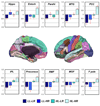Brain substrates of learning and retention in mild cognitive impairment diagnosis and progression to Alzheimer's disease
- PMID: 20034503
- PMCID: PMC2851550
- DOI: 10.1016/j.neuropsychologia.2009.12.024
Brain substrates of learning and retention in mild cognitive impairment diagnosis and progression to Alzheimer's disease
Abstract
Understanding the underlying qualitative features of memory deficits in mild cognitive impairment (MCI) can provide critical information for early detection of Alzheimer's disease (AD). This study sought to investigate the utility of both learning and retention measures in (a) the diagnosis of MCI, (b) predicting progression to AD, and (c) examining their underlying brain morphometric correlates. A total of 607 participants were assigned to three MCI groups (high learning-low retention; low learning-high retention; low learning-low retention) and one control group (high learning-high retention) based on scores above or below a 1.5 SD cutoff on learning and retention indices of the Rey Auditory Verbal Learning Test. Our results demonstrated that MCI individuals with predominantly a learning deficit showed a widespread pattern of gray matter loss at baseline, whereas individuals with a retention deficit showed more focal gray matter loss. Moreover, either learning or retention measures provided good predictive value for longitudinal clinical outcome over two years, although impaired learning had modestly better predictive power than impaired retention. As expected, impairments in both measures provided the best predictive power. Thus, the conventional practice of relying solely on the use of delayed recall or retention measures in studies of amnestic MCI misses an important subset of older adults at risk of developing AD. Overall, our results highlight the importance of including learning measures in addition to retention measures when making a diagnosis of MCI and for predicting clinical outcome.
Keywords: Amnestic MCI; Early detection; Episodic memory; Longitudinal outcome; MR morphometry.
(c) 2009 Elsevier Ltd. All rights reserved.
Conflict of interest statement
Conflict of interest: Anders M. Dale is a founder and holds equity in CorTechs Labs, Inc., and also serves on the Scientific Advisory Board. The terms of this arrangement have been reviewed and approved by the University of California, San Diego in accordance with its conflict of interest policies. The other authors do not have a financial or any other conflict of interest to disclose related to this manuscript.
Figures



Similar articles
-
11C PiB and structural MRI provide complementary information in imaging of Alzheimer's disease and amnestic mild cognitive impairment.Brain. 2008 Mar;131(Pt 3):665-80. doi: 10.1093/brain/awm336. Epub 2008 Feb 7. Brain. 2008. PMID: 18263627 Free PMC article.
-
[Neuropsychological impairment in the early Alzheimer's disease].Encephale. 2007 May-Jun;33(3 Pt 1):310-6. doi: 10.1016/s0013-7006(07)92044-8. Encephale. 2007. PMID: 17675928 Review. French.
-
Neuropsychological prediction of conversion to Alzheimer disease in patients with mild cognitive impairment.Arch Gen Psychiatry. 2006 Aug;63(8):916-24. doi: 10.1001/archpsyc.63.8.916. Arch Gen Psychiatry. 2006. PMID: 16894068
-
Choroid plexus volumes and auditory verbal learning scores are associated with conversion from mild cognitive impairment to Alzheimer's disease.Brain Behav. 2024 Jul;14(7):e3611. doi: 10.1002/brb3.3611. Brain Behav. 2024. PMID: 38956818 Free PMC article.
-
Neuropsychological features of mild cognitive impairment and preclinical Alzheimer's disease.Acta Neurol Scand Suppl. 2003;179:34-41. Acta Neurol Scand Suppl. 2003. PMID: 12603249 Review.
Cited by
-
Verbal serial list learning in mild cognitive impairment: a profile analysis of interference, forgetting, and errors.J Int Neuropsychol Soc. 2011 Sep;17(5):905-14. doi: 10.1017/S1355617711000944. J Int Neuropsychol Soc. 2011. PMID: 21880171 Free PMC article.
-
A deep learning MRI approach outperforms other biomarkers of prodromal Alzheimer's disease.Alzheimers Res Ther. 2022 Mar 29;14(1):45. doi: 10.1186/s13195-022-00985-x. Alzheimers Res Ther. 2022. PMID: 35351193 Free PMC article.
-
Distinct structural correlates of the dominant and nondominant languages in bilinguals with Alzheimer's disease (AD).Neuropsychologia. 2019 Sep;132:107131. doi: 10.1016/j.neuropsychologia.2019.107131. Epub 2019 Jul 1. Neuropsychologia. 2019. PMID: 31271821 Free PMC article.
-
Faulty Adaptation to Repeated Face-Name Associative Pairs in Mild Cognitive Impairment is Predictive of Cognitive Decline.Arch Clin Neuropsychol. 2018 Mar 1;33(2):168-183. doi: 10.1093/arclin/acx056. Arch Clin Neuropsychol. 2018. PMID: 28655152 Free PMC article.
-
A novel computer adaptive word list memory test optimized for remote assessment: Psychometric properties and associations with neurodegenerative biomarkers in older women without dementia.Alzheimers Dement (Amst). 2022 Mar 9;14(1):e12299. doi: 10.1002/dad2.12299. eCollection 2022. Alzheimers Dement (Amst). 2022. PMID: 35280963 Free PMC article.
References
-
- Albert MS, Moss MB, Tanzi R, Jones K. Preclinical prediction of AD using neuropsychological tests. Journal of International Neuropsychological Society. 2001;7(5):631–639. - PubMed
-
- Arnaiz E, Almkvist O. Neuropsychological features of mild cognitive impairment and preclinical Alzheimer's disease. Acta Neurologica Scandinavica Supplementum. 2003;179:34–41. - PubMed
-
- Axmacher N, Schmitz DP, Weinreich I, Elger CE, Fell J. Interaction of working memory and long-term memory in the medial temporal lobe. Cerebral Cortex. 2008;18(12):2868–2878. - PubMed
Publication types
MeSH terms
Grants and funding
LinkOut - more resources
Full Text Sources
Medical
Research Materials

